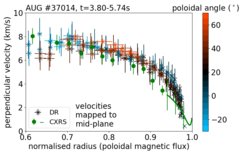Longstanding model of perpendicular propagation velocity of density fluctuations confirmed
The perpendicular velocity of density fluctuations measured by Doppler reflectometry has the same poloidal variation as the E×B velocity.
Fusion power plants need high energy confinement times which are mainly limited by turbulence-driven heat transport. Turbulence suppression by shear flows where turbulence eddies are decorrelated is a widely accepted mechanism for transport reduction and motivates a detailed understanding of turbulence and flows for device planning.

The propagation velocity of density fluctuations perpendicular to the magnetic field can be measured by Doppler reflectometry. Other fusion devices reported poloidal asymmetries of this perpendicular velocity which have not yet been understood. Comprehensive research done at ASDEX Upgrade could not reproduce these asymmetries. A sensitivity study of the input parameters, such as plasma density, magnetic equilibrium or diagnostic alignment was carried out to discuss possible sources of artificial asymmetries.
In the plot the velocities measured at various poloidal angles match well for all radii. This confirms the idea that the perpendicular plasma flow is essentially given by the E×B drift, with the electrostatic potential on a flux surface being constant. In addition they match well with data from charge exchange recombination spectroscopy (CXRS) and thus support previous findings of a small turbulent phase velocity in the plasma core.
This work was published in K Höfler et al 2021 Plasma Phys. Control. Fusion 63 035020
